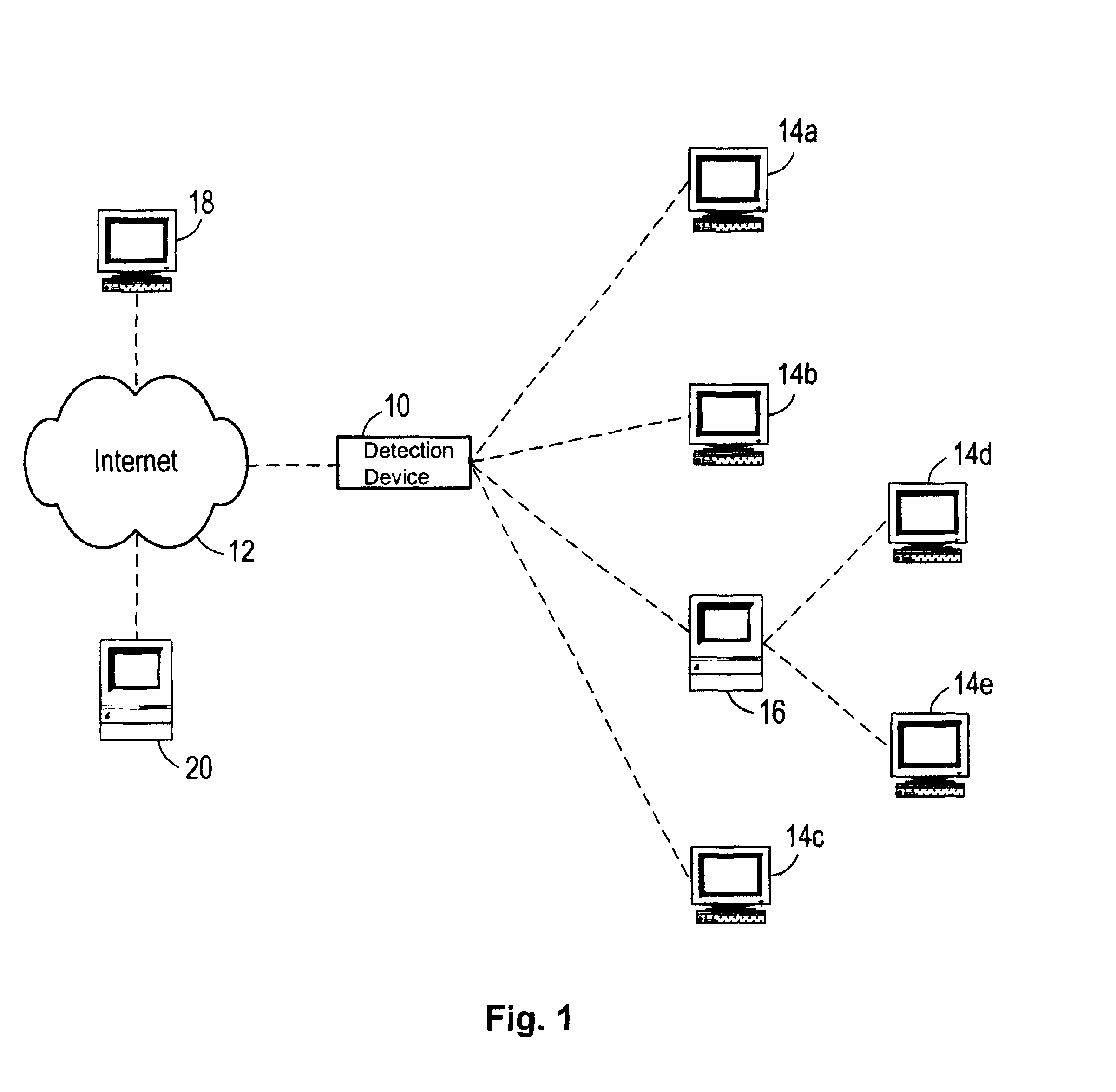Content pattern recognition language processor and methods of using the same
a content pattern and language processor technology, applied in the field of system and method for detecting content of computer and network traffic, can solve problems such as computer virus generation and spreading, complete destruction of data on a user's hard drive or server, and computer virus
Active Publication Date: 2012-03-20
FORTINET
View PDF43 Cites 15 Cited by
- Summary
- Abstract
- Description
- Claims
- Application Information
AI Technical Summary
Benefits of technology
The invention is a device or computer program that can detect specific content in network traffic. It does this by using a processor and a memory to receive a signature that is associated with the desired content. The signature is made up of predicates that can be compiled into a byte code stream to control the device's logic. This allows for the efficient detection of network traffic content that matches the desired content.
Problems solved by technology
The generation and spreading of computer viruses are major problems in computer systems and computer networks.
The damage that can be done by a computer virus may range from mild interference with a program, such as a display of unsolicited messages or graphics, to complete destruction of data on a user's hard drive or server.
However, these organizations may still be vulnerable to a virus attack until every host in their network has received updated anti-virus software.
Furthermore, anti-virus programs that operate at the application-level require enormous computing resources, making such anti-virus programs expensive to deploy and manage.
Besides virus attacks, many organizations also face the challenge of dealing with inappropriate content, such as email spam, misuse of networks in the form of browsing or downloading inappropriate content, and use of the network for non-productive tasks.
Many organizations are struggling to control access to appropriate content without unduly restricting access to legitimate material and services.
However, such approach may be unnecessarily restrictive, preventing access to valid content in web sites that may contain only a limited amount of undesirable material.
However, spammers often launch email spam from different hosts every time, making it difficult to maintain a list of spam servers.
Method used
the structure of the environmentally friendly knitted fabric provided by the present invention; figure 2 Flow chart of the yarn wrapping machine for environmentally friendly knitted fabrics and storage devices; image 3 Is the parameter map of the yarn covering machine
View moreImage
Smart Image Click on the blue labels to locate them in the text.
Smart ImageViewing Examples
Examples
Experimental program
Comparison scheme
Effect test
examples
FRX(“badsite\.com”)
[0186]matches exact string ‘badsite.com’
FRX(“badsite[0-9]\.com”)[0187]Matches badsite followed by a number and then ‘.com’, for example
‘badsite1.com’, ‘badsite2.com’, etc.
FRX(“badsite[s]?\.com”)[0188]Matches ‘badsite.com’ or ‘badsites.com’.
FRX(“badsite\.com$”)[0189]Matches any string that end with ‘badsite.com’, such as ‘www.badsite.com’,
the structure of the environmentally friendly knitted fabric provided by the present invention; figure 2 Flow chart of the yarn wrapping machine for environmentally friendly knitted fabrics and storage devices; image 3 Is the parameter map of the yarn covering machine
Login to View More PUM
 Login to View More
Login to View More Abstract
A device for detecting network traffic content is provided. The device includes a processor configured to receive a signature associated with content desired to be detected, and execute one or more functions based on the signature to determine whether network traffic content matches the content desired to be detected. The signature is defined by one or more predicates. A computer readable medium for use to detect network traffic content is also provided. The computer readable medium includes a memory storing one or more signatures, each of the one or more signatures associated with content desired to be detected. Each of the one or more signatures is defined by one or more predicates, and each of the one or more predicates can be compiled into a byte code stream that controls a logic of a network traffic screening device.
Description
RELATED APPLICATION DATA[0001]This application claims priority to U.S. Provisional Application Nos. 60 / 397,147, 60 / 397,304, 60 / 397,033, 60 / 397,302, and 60 / 397,034, all filed Jul. 19, 2002, the disclosures of which are expressly incorporated by reference herein.BACKGROUND OF THE INVENTION[0002]1. Field of the Invention[0003]The field of the invention relates to computer systems and computer networks, and more particularly, to systems and methods for detecting content of computer and network traffic.[0004]2. Background of the Invention[0005]The generation and spreading of computer viruses are major problems in computer systems and computer networks. A computer virus is a program that is capable of attaching to other programs or sets of computer instructions, replicating itself, and / or performing unsolicited or malicious actions on a computer system. Viruses may be embedded in email attachments, files downloaded from Internet, and macros in MS Office files. The damage that can be done ...
Claims
the structure of the environmentally friendly knitted fabric provided by the present invention; figure 2 Flow chart of the yarn wrapping machine for environmentally friendly knitted fabrics and storage devices; image 3 Is the parameter map of the yarn covering machine
Login to View More Application Information
Patent Timeline
 Login to View More
Login to View More Patent Type & Authority Patents(United States)
IPC IPC(8): G06F15/173
CPCH04L63/0236H04L63/145H04L63/1425H04L63/1441H04L43/10H04L63/1416H04L43/04H04L63/0245
Inventor WELLS, JOSEPHXIE, MICHAEL
Owner FORTINET
Features
- R&D
- Intellectual Property
- Life Sciences
- Materials
- Tech Scout
Why Patsnap Eureka
- Unparalleled Data Quality
- Higher Quality Content
- 60% Fewer Hallucinations
Social media
Patsnap Eureka Blog
Learn More Browse by: Latest US Patents, China's latest patents, Technical Efficacy Thesaurus, Application Domain, Technology Topic, Popular Technical Reports.
© 2025 PatSnap. All rights reserved.Legal|Privacy policy|Modern Slavery Act Transparency Statement|Sitemap|About US| Contact US: help@patsnap.com



